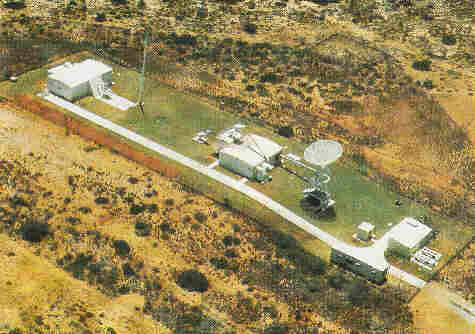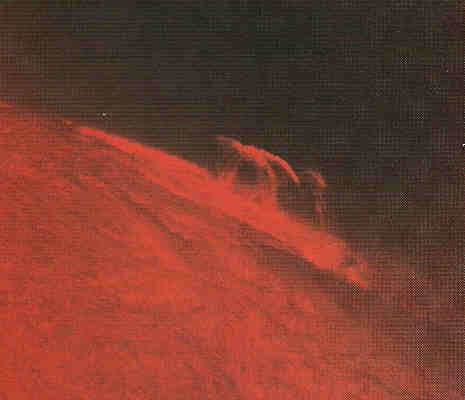
by John A Kennewell
The article presented here first appeared in the
November 1984 issue of ASCENT magazine,
the in-house journal of the Department of Science and
Technology (Australian Commonwealth Government).
It is one of the first articles to make analogies between
phenomena in the near space environment with those of terrestrial
(tropospheric) meteorology. This preceded the popular acceptance
of the idea of "space weather" that originated in the USA, by
more than six years.

|
SPACE METEOROLOGY
by John A Kennewell |
Galileo, who, 400 years ago, was the first to observe telescopically dark spots on the Sun, is widely regarded as the first to reveal the Sun's dynamic nature. Although these dark spots have been recorded intermittently since Galileo's time it is only recently, with our increasing use of technological systems and our expansion into space, that we have come to realise the importance of the Sun's dynamic nature.
Most of the Sun's energy is released in the form of heat and light which is the source of our continued existence. It is also the source of the Earth's weather.
Movement of air masses, formation of clouds, and severe weather hazards all result from the input of solar heat into the troposphere, the lower most region of our atmosphere. Heat and light, however, although a very important biological part, form only a part of the spectrum of possible electromagnetic radiation.
The Sun is a very broadband radiator and emits varying quantities of radio waves which are lower in frequency than heat or infrared radiation, and ultraviolet, X- and gamma rays which are higher in frequency than light. The Sun also emits a constant stream and irregular bursts of high energy particles which impinge on the Earth's outer atmosphere. Fortunately most of this corpuscular and electromagnetic radiation is intercepted before it reaches the Earth's surface.
Apart from seeing an occasional aurora and suffering a mild case of sunburn the average individual is probably unaware of the tumultuous interplay of cosmic forces that are occuring all the time in our skies.
Solar particles are deflected or entrapped by the terrestrial magnetic field which surrounds us like a protective cocoon. Protons and electrons spiral along the magnetic field lines at very high speeds. Huge sheets of current encircle the globe. Under quiet conditions all these forces are balanced and the magnetosphere is calm. But the stream of particles emanating from the Sun and the solar wind are not always constant as they cross the interplanetary sea. Solar flares, disappearing filaments and coronal holes, which are all part of the Sun's dynamic nature, can produce shock waves which travel as tsunamis across the boundless gulf to our shores. They strike the Earth's magnetic field a reeling blow which sets off a magnetic storm that can last for days.
In contrast to this, ultraviolet and X-radiations pass straight through the magnetosphere only to be intercepted by atmospheric layers lower down, although still well above the troposphere. They deposit their energy here forming clouds of ionisation where the neutral atoms and molecules of air have been stripped of some of their outer electrons. These clouds are sometimes in the shape of uniform layers called stratiform and sometimes appear as irregular patches. They form, move and reform in a daily cycle and, collectively known as the ionosphere, are at the whim of the solar character, showing variations as it does.
In the interplanetary medium between the surface of the Sun and the Earth's upper atmosphere there is a space filled with both matter and energy that is primarily controlled by electromagnetic forces. This space may appear in a relatively quiescent state or it may erupt into a seething cosmic cauldron.

Information and forecasts on space meteorology are provided in Australia by the Ionospheric Prediction Service (IPS) run by the Department of Science and Technology. This information is of particular interest to:
Magnetospheric storms will induce large currents in long pipelines which can cause severe corrosion problems. The same currents can also trip circuit breakers in lengthy electrical power grids. Significant magnetic activity can also disrupt aerial magnetic surveys used by geophysical exploration companies for locating significant ore bodies.

Apart from seeing an occasional aurora
and suffering a mild case of sunburn
the average individual is probably unaware
of the tumultuous interplay of cosmic forces
that are occuring all the time in our skies.

The IPS operates a number of ionospheric sounding stations around and
outside Australia to provide information on the state of the ionosphere.
These stations use radars that can measure the concentration of
ionisation at heights throughout the atmosphere from 80 to 800 kilometres.
They provide a photographic record of how the ionosphere has changed
and are the basis of long term predictions. These radars, designed
by IPS and now manufactured by Australian industry, have become the
instruments used worldwide for monitoring the ionosphere.
To make immediate forecasts, and to understand why the ionosphere is changing, it is essential to go to the source of both the ionosphere and its disturbances: the Sun. From the ground it is possible to observe both the light and the radio waves that are emitted by the Sun, but to monitor its X-ray output we must use satellites high above the layers of atmospheric absorption.
Information for the IPS Regional Warning Centre in Sydney is received from three solar observatories in Australia:

The solar observatory at Learmonth is a prime example of productive international co-operation. Established under an agreement as part of a global observatory network, it is managed jointly by the USAF Air Weather Service and IPS. Its primary purpose is to maintain a continuous radio and optical patrol of the Sun from dawn to dusk.
Information on solar disturbances is monitored and passed within minutes to both Australian and US forecast centres. The use of multiple radio frequencies and various optical filters and techniques results in the extraction of maximum data on the activity of our nearest star through all its various atmospheric layers. It is even possible to watch some high energy particles as they crash their way up through the solar atmosphere (corona) at speeds around 1000 kilometres per hour.
What we also believe to be the underlying source of all solar activity, the photospheric magnetic fields, can also be plotted with the aid of a telescope accessory, the magnetograph, which makes use of an interesting physical principle called the Zeeman effect. Monitoring solar magnetic fields and how they change is one of the best ways of predicting explosive solar activity.
CSIRO first revealed the form and nature of the various radio emissions from the Sun during research it carried out in the early 1950s. As we have become more dependent on technology we have come to realise how vital it is to continuously monitor these and other solar outbursts. We have come to understand how the solar-induced meteorology of space can affect us and our technical extensions. Only by global monitoring of the Sun-Earth system, with a rapid response time for meaningful forecasts, can we hope to continue our progress and learn to adapt to our space environment. The Department of Science and Technology through its Ionospheric Prediction Service is making a significant contribution to this progress.
NOTES

Australian Space Academy